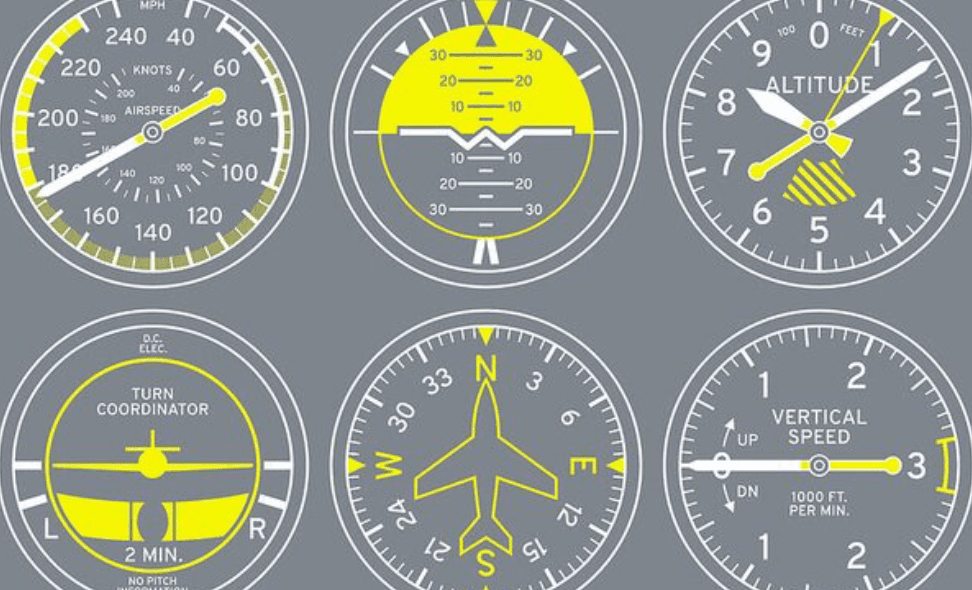
For pilots, mastering the six-pack of aviation instruments is essential for safe and effective flight. These six primary flight instruments provide critical information about an aircraft’s attitude, altitude, speed, and direction, allowing pilots to navigate and control their aircraft in various conditions. Whether flying in clear skies or challenging weather, understanding how to read and interpret these instruments is fundamental to aviation. In this blog, we’ll take a deep dive into the six-pack of flight instruments, exploring their functions, how they work, and why they are indispensable to pilots.
The six-pack refers to the six primary flight instruments that are traditionally found in a standard aircraft cockpit. These instruments are typically arranged in two rows of three and include:
Airspeed Indicator
Attitude Indicator
Altimeter
Turn Coordinator
Heading Indicator
Vertical Speed Indicator
Each of these instruments provides a unique piece of information about the aircraft’s flight status. Together, they give pilots a comprehensive understanding of their situation in the sky.
The airspeed indicator measures the aircraft’s speed relative to the surrounding air. This is crucial for maintaining proper flight speeds, including takeoff, cruise, approach, and landing speeds.
The ASI operates using the pitot-static system, which compares dynamic air pressure from the pitot tube with static air pressure. The difference between these pressures determines the aircraft’s speed.
Helps pilots maintain safe operating speeds
Prevents stalls or exceeding structural limits
Provides information on best climb and glide speeds
The attitude indicator, also known as the artificial horizon, displays the aircraft’s orientation relative to the horizon.
Using a gyroscope, the AI provides a real-time depiction of pitch (nose-up or nose-down) and bank (left or right tilt). The instrument remains stable while the aircraft moves around it, providing a reliable reference in low visibility conditions.
Critical for instrument flight in poor visibility
Helps maintain level flight and controlled turns
Provides immediate orientation awareness to pilots
The altimeter measures the aircraft’s altitude above mean sea level (MSL), allowing pilots to maintain safe and legal flight levels.
The altimeter is part of the static pressure system and operates using an aneroid barometer. It measures changes in atmospheric pressure and converts them into altitude readings.
Ensures separation from terrain and other aircraft
Helps pilots comply with altitude restrictions and regulations
Aids in determining safe descent and landing altitudes
The turn coordinator provides information about the rate of turn and coordination of the aircraft.
It consists of a gyroscope that senses roll and yaw motion and a small inclinometer (the “ball”) that indicates whether a turn is coordinated (meaning no excessive slip or skid).
Ensures properly coordinated turns
Prevents dangerous skids or slips, especially in instrument flight
Useful backup for attitude reference in case of failure of other instruments
The heading indicator displays the aircraft’s heading in degrees, relative to magnetic north.
Unlike a magnetic compass, which can be affected by acceleration and turning errors, the HI operates using a gyroscope to maintain a stable heading reference. Pilots must periodically adjust it to match the magnetic compass.
Provides a stable and reliable heading reference
Essential for navigation, especially under instrument flight rules (IFR)
Reduces reliance on the magnetic compass, which can be inaccurate during turns
The VSI indicates the rate of climb or descent in feet per minute (FPM), helping pilots maintain controlled altitude changes.
The VSI uses the static pressure system and measures the rate of change in atmospheric pressure. A delayed response feature helps smooth out minor fluctuations in altitude.
Helps pilots establish and maintain smooth climbs and descents
Aids in leveling off at a desired altitude
Provides early warning of inadvertent altitude changes
These six instruments work together to provide a complete picture of an aircraft’s flight status. Pilots rely on them in all phases of flight, especially when visual references are limited or unavailable, such as during night flights or in adverse weather conditions.
The airspeed indicator ensures safe speed management.
The attitude indicator provides critical orientation data.
The altimeter maintains altitude awareness and safety.
The turn coordinator aids in proper turn coordination.
The heading indicator supports precise navigation.
The vertical speed indicator helps control climb and descent rates.
While traditional analog instruments are still widely used, modern aircraft are increasingly equipped with Electronic Flight Instrument Systems (EFIS), or glass cockpits. These digital displays consolidate the six-pack into primary flight displays (PFDs), reducing pilot workload and increasing situational awareness. Despite these advancements, understanding the six-pack remains fundamental for all pilots, as it provides a foundational knowledge of flight instrumentation.
The six-pack of aviation instruments is the backbone of flight control and navigation. From ensuring safe speeds to maintaining altitude and proper orientation, these instruments provide pilots with the essential data needed to fly safely and efficiently. Whether you’re a student pilot, an experienced aviator, or simply an aviation enthusiast, mastering the six-pack is a crucial step in understanding the art and science of flying.
As aviation technology continues to evolve, the principles behind these instruments remain unchanged, proving that a strong foundation in the basics is vital for every pilot. Next time you step into a cockpit, take a moment to appreciate the six-pack—it’s what keeps pilots connected to the skies.
Back to Articles